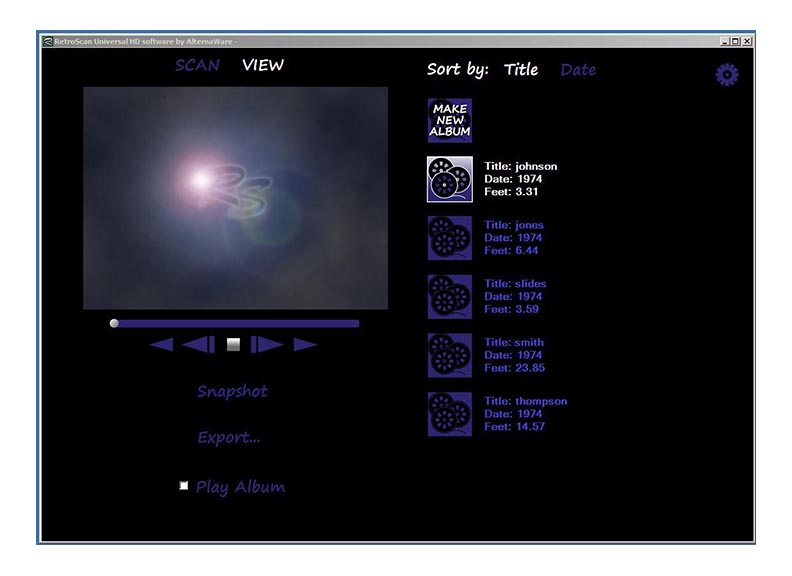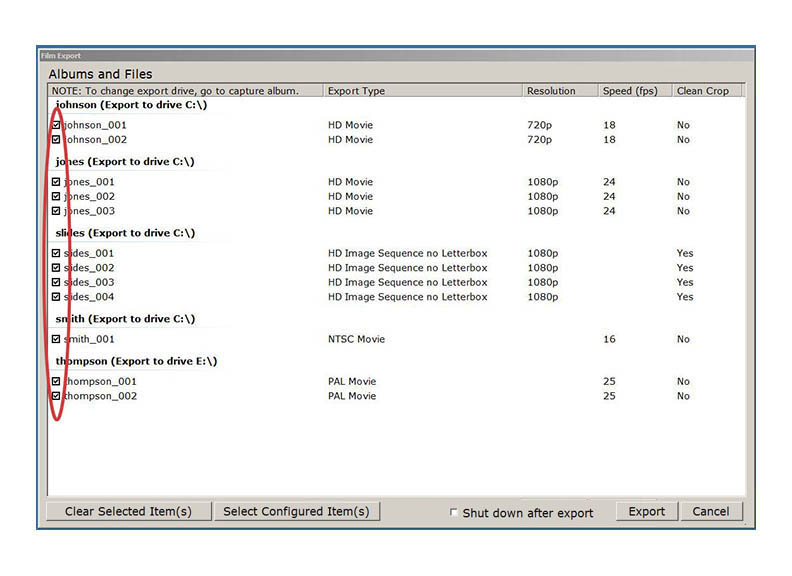- RetroScan-HD Universal View/Export Functions -
When you click on "View" at the top of the software, the screen will change to this:

If you click on "Export", you will find this screen, which can be resized easily by grabbing the edges or corners.It should be noted that the Universal does not scan to a video file, which can degrade quality. Instead, the Universal RetroScan software scans to a series of individual high resolution still frames in a proprietary folder. These stills are stored in such a way that you can play them back rapidly enough to see motion to check your movie after scanning.
To view a file, open an album and click on a file to load it into the player. The playback controls under the window are traditional with a scroll bar. Pressing "Snapshot" will produce a single 1080 resolution still of the frame visible on screen. Snapshot can be used when the film being played as well. All snapshots will be found in the "Export" folder on your chosen export drive and are suitable for making small prints or for use as DVD covers. "Play Album" will play the entire contents of any album that has been opened.
To edit any of these files, you must first export them to a format that is compatible with your preferred edit program for your PC or Mac. Your choice of export formats are SD or HD as both .MOV video files as well as JPG, PNG, BMP and TIF numbered image sequences. Most people that want image sequences stick with JPG due to high quality and small file size.

Note that each folder displays the destination drive for export. If you wish to change the export drive of any given album, just close out this screen, change the drive selection in the album in question, then return to the export screen. You will not lose any of your settings on this screen.
Home movies and other films are often shot at a variety of frame rates, such as 16fps for Regular 8, 18fps for Super 8 and 24fps for 16mm. Also, some people might want their films to be exported as standard def (SD) or high def (HD). As noted above, others might want their films to be exported as a numbered image sequence where each frame of film is maintained on an individual still frame. Numbered image sequences offer the absolute highest quality because the video file is created by your computer in whatever codec is unique to your edit system. Not all edit systems can import numbered image sequences so check with your system's users manual for directions on use of numbered image sequences.

To apply needed speeds, resolutions and formats, just single click a file to select it.

Left click on the selected file directly under the "Export Type" column .
Use the drop down boxes to choose the type of output you want.
Do the same for "Resolution", "Speed" and "Clean Crop".
NOTE: These selections must be made or you can not export your file.
NTSC is the SD format for North America and Japan.
PAL is the SD format for the UK and Europe.
NOTE: If you wish to apply a choice to multiple files at once, just highlight the first file under
"Export Type", hold down the "shift" key, then highlight the last file under "Export Type".
While all selections are highlighted, use the drop down menu to make your Export Type choice.
Do the same thing under Resolution, Speed and Clean Crop, as desired.

In this example, the file will be output as a 720p HD movie at 17fps. The "Clean Crop" function is handy if you have images with hair or debris on the edges and don't want to rescan the images again. Changing Clean Crop to "Yes" will perform a gentle 10% crop into the image and resize it back to the desired resolution, thus leaving out the offending debris on the edges of the frame.
If you need to "undo" any of your selections, just hi-lite that file
and use the "Clear Selected Item(s)" button.
Once you have made all your choices, check the box of each file that you wish to export.
Any file not checked will be left out of that export. All exported files will be found in the Export folder of your export drive. NOTE: If you do not make selections regarding export type, resolution and speed, you will not be able to check the box to the left.
If you wish to check all the boxes for configured files at one time,
use the "Select Configured Items" button.
Just click the "EXPORT" button at the bottom to start your export.
You can have the software automatically shut down the PC after it completes export by checking the shut down box. This will help to protect against needless wear on your PC.
If you have any questions, please feel free to email at
retrofix@swtexas.net or call us at 830-966-4664.
Click HERE to go back to beginning.
All information and imagery copyright 2016 MovieStuff, LLC
All right reserved.



